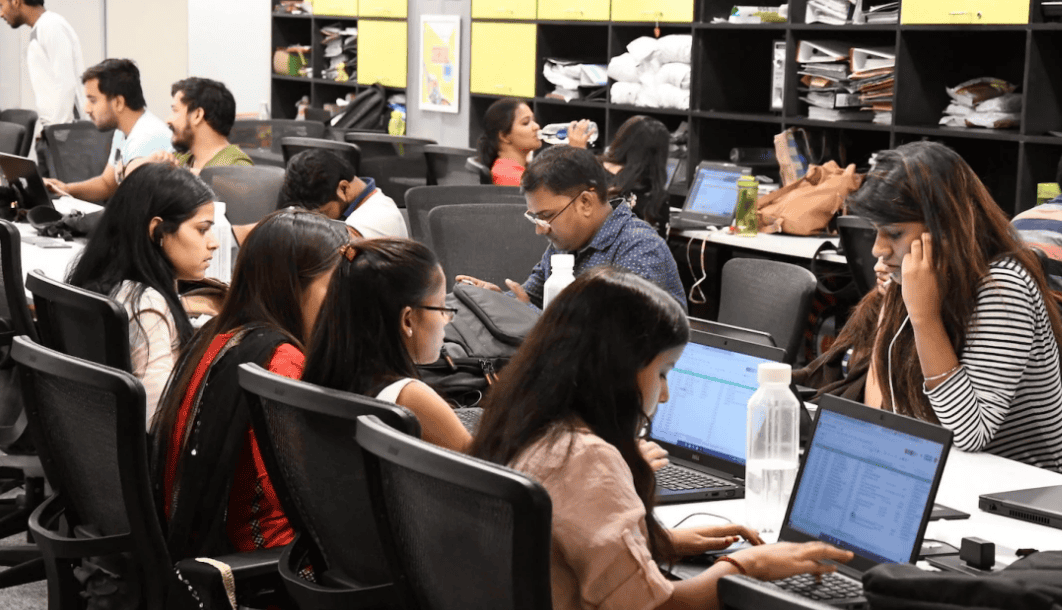Economic downturns can have lasting and ‘scarring’ effects on career trajectories. Using data from India, this column finds only a marginal difference in the likelihood of finding employment between those entering the labour market during the Covid-19 pandemic and pre-pandemic entrants, but significant differences in both the types of jobs they were able to get and their earnings from those jobs. In addition, subsequent entrants, despite not entering during an economic downturn, may pay the price of compromised schooling during the lockdown.
For many young adults, their first job post-graduation marks a significant milestone, symbolising their entry into the workforce and representing personal and familial achievement following years of education and training investment. Studies suggest that the first job determines an individual’s lifetime career trajectory, influencing future earnings and job quality (Cavero and Ruiz 2016). This ‘path dependence’ has important implications, impacting individuals’ income and employment status well into their middle-age.
As young adults begin their careers, their employment prospects are influenced not only by their qualifications but also by various societal factors. In India, factors like caste, religion, and race often dictate job opportunities, with social connections playing a significant role in hiring decisions. Demographics can also impact job prospects, with some evidence suggesting that cohort size affects youth employment rates. Economic conditions play a pivotal role, as demonstrated by Kahn (2010), who found that recession-era graduates faced lower wages and job quality. Wachter (2020) estimated potential earning losses of $400 billion over a decade for the 2020 labour market entrants. Atherwood and Sparks (2019) note that recession-era entrants experienced lower wages; however, these effects were somewhat mitigated for those with higher education.
The Covid-19 pandemic, aside from its health toll, inflicted significant economic damage. Some forecasters at the time predicted that the global economy would shrink by 5.2% in 2020. 1 It severely impacted labour markets worldwide, varying in degree and duration. The Indian government imposed one of the strictest lockdowns globally on 24 March 2020 (Mathieu et al. 2020). During this time, at least one cohort of young graduates entered the labour market, facing challenges in securing employment. They were more likely to secure low-paying and informal jobs. Economic downturns can have lasting and ‘scarring’ effects on career trajectories, as evidenced by studies in other contexts. To assess this impact, in a recent paper (Abraham and Jha 2023) we analyse high-frequency labour market data for India, tracking young workers entering at different times and comparing their job outcomes.
The data we use are collected by the Centre for Monitoring Indian Economy (CMIE). Every year, a sample of households are interviewed in four-month intervals, with data being collected on their employment, income, and other earnings. Using these data, we track a subgroup of individuals who are identified as young entrants who would have entered the labour market in 2020, i.e. the year of the pandemic. 2 These individuals are between the ages of 18 and 23, report themselves as students, and were out of the labour force in 2019, likely entering the labour market in the following year. We follow this sample of individuals until 2022 3 and document their employment trajectories, along with their corresponding incomes. These outcomes are compared with a baseline sample of young adults who entered the labour market in ‘normal’ times – specifically, the baseline is those individuals who were students, out of the labour force, and in the 18-23 age bracket in 2018 and who entered the labour market in 2019 (a ‘normal’ year).
We compare the employment outcomes of two cohorts: (1) the ‘pandemic’ cohort whose employment and earnings are tracked in 2020 and in 2022; and (2) and the pre-pandemic, or ‘baseline’, cohort who entered in 2019. Comparing the outcomes for these two cohorts provides insight into the differences resulting from entering the labour market during the pandemic year. In doing so, we examine whether there are any penalties or ‘scarring’ effects associated with entering the labour market during an economic crisis. Since we only have two years of data for the pandemic cohort, we cannot comment on the long-term impact. Instead, we use employment and income information for this cohort from two years, 2020 and 2022, to assess the impact and recovery compared to the baseline.
Young entrants before the Covid-19 pandemic
We begin by observing employment outcomes of our ‘baseline’ sample – young workers who entered in 2019. The employment outcome of interest falls into three categories: first, whether they found employment, remained unemployed, or chose to remain out of the labour force; second, conditional on having found employment, what kind of employment were they able to obtain upon entering the labour market; and finally, the earnings across different employment types for these entrants in 2019.
Our baseline sample comprises 33,230 youngsters who are tracked in 2019 to observe their outcomes. Of these, 9% were employed in 2019, 15% were not able to find employment, and 76% remained out of the labour force (Figure 1).
Figure 1 Distribution of the baseline/pre-pandemic cohort and the pandemic cohort




Among those who were able to find employment, around 10% were absorbed in permanent-salaried jobs. Close to 25% of these workers were in temporary-salaried positions, while another 25% were in casual or daily-wage roles. The remaining roughly 40% reported themself as self-employed in 2019 (Figure 2).
The average real monthly income of these workers in 2019 was Rs. 9,588. As expected, the highest average earnings were for those in permanent-salaried work, at Rs. 16,727. The lowest was for those in daily wage work, earning Rs. 7,421 on an average each month (Figure 3).
Figure 2 Type of employment secured by labour market entrants in 2019, and those entering in 2020 tracked in 2022




Figure 3 Average monthly earnings of pandemic and baseline cohort, by employment type




Young entrants during the pandemic
What did these employment outcomes look like for the pandemic cohort? The only significant difference between the pre-pandemic and the pandemic cohorts will be the year in which they entered the market, i.e. 2020 instead of 2019. Further, we tracked this cohort in 2020 and 2022. The analysis is based on 27,636 individuals who form part of the balanced panel of the pandemic cohort (i.e. individuals who were interviewed in all three years – 2019, 2020, and 2022).
Of these labour market entrants, 6% were able to find employment in 2020, 13% remained unemployed, and 82% continued to remain out of the labour force. The labour force thus contracted by around six percentage points in the pandemic year due to the young entrants, compared to the normal pre-pandemic year reported above. While this suggests a drop in supply of workers, it could also reflect an implicit decrease in labour demand, which was reflected in workers choosing not to enter the labour market, unlike their pre-pandemic counterparts. Further, even two years after having entered the labour market (i.e. in 2022), only around 10% of the young entrants in the pandemic cohort were able to find employment.
We analyse the types of employment they secured and how it compares with their predecessors. There was a drop in the percentage of individuals who were able to get into the most secure form of employment, namely, permanent-salaried. The proportion dropped to 7% among the pandemic cohort. A greater proportion of the pandemic cohort got absorbed in daily wage work and self-employment, the more precarious kinds of employment, in comparison to the baseline pre-pandemic cohort. The pandemic cohort, however, did show signs of recovery in about two-years’ time. By 2022, the proportion of workers in permanent salaried jobs had increased up to 12% and the self-employed had fallen to 33%. However, the proportion of daily wage workers and those in temporary salaried jobs continued to remain higher than the respective proportions in the pre-pandemic cohort.
The average real monthly income (in 2019 prices) of the pandemic cohort of entrants who found employment in 2020 was Rs. 3,946. This implies that, compared to the baseline pre-pandemic cohort, the pandemic cohort had an average monthly income around 60% lower. The income difference also varied depending on the type of employment. The difference in incomes for the daily wage workers and the self-employed of the pandemic cohort compared to their pre-pandemic counterparts was the highest, at 62%. The difference was the least for the permanent salaried workers of the pandemic cohort, whose income was 38% lower than the pre-pandemic cohort.
In the paper we also provide a detailed breakdown of how the pandemic cohort was rewarded in the market after gaining two years of experience. While their experiences varied depending on the type of employment, there was a general penalty in terms of the increment in their earnings two years after entering the market.
The pandemic cohort of employed workers was able to make only around 9% higher income compared to the starting income of the pre-pandemic cohort. By 2022, the permanent salaried workers of the pandemic cohort were making 22% higher income than the starting income of the permanent salaried workers of the pre-pandemic cohort, while the temporary salaried workers of the pandemic cohort continued to make 4% lower income even after two years as compared to the starting income of their pre-pandemic counterpart. The increment in earnings of the daily wage workers and the self-employed after two years of working was only around 5-7% higher than the starting salary of the respective workers in the baseline pre-pandemic year cohort.
Conclusion
Comparing the young entrants of the labour market in the pandemic year with those in the pre-pandemic year, we find that the penalty in terms of finding a job is marginal when only considering the metric of finding employment versus remaining unemployed or out of the labour force. However, there exists a significant difference for the pandemic cohort in both the types of jobs they are able to get and their earnings from these jobs. Our findings suggest a ‘scarred’ cohort of workers, making it imperative for policy interventions to ameliorate this damage. Policy interventions that help better match workers with jobs can help reallocate these young workers to more secure and well-paying jobs and allow for a course correction in their labour market trajectories. Further, subsequent entrants, although not entering during an economic downturn, may pay the price of compromised schooling during the lockdown. Remedial classes, vocational training and apprenticeships can potentially address this challenge.
With India well into the golden period of demographic dividend, employing the youth in meaningful, quality jobs is critical not only from a socioeconomic concern but also to reap the maximum benefits from this demographic phase.
Source : VOXeu






